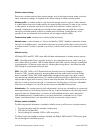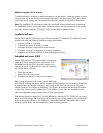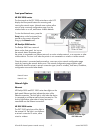Wireless network settings
Devices on a wireless network share certain settings, such as the communication mode, a network
name, and security settings. A complete set of network settings is called a wireless profile.
Wireless profile—a wireless profile is a set of network settings unique to a given wireless network.
A wireless device may have wireless profiles for several wireless networks. In order to use a printer
or other device, a computer must be set to the profile for the device’s wireless network. For
example, a laptop that is used both at work and at home might have one profile for a wireless
network at work and another profile for a wireless network at home. Printing devices, which
typically do not move between work and home, do not support multiple profiles.
Communication mode—Infrastructure or ad hoc mode (see above).
Network name—a network name, or “Service Set Identifier (SSID),” identifies a particular wireless
network. It is an alphanumeric, case-sensitive character string that provides basic access control to
a wireless network. In order to operate on a network, a device must be set to the network's network
name.
Network security
HP Deskjet 5800 and PSC 2500 series offer the latest advancements in wireless network security:
WEP—Wired Equivalent Privacy provides security by encrypting data sent over radio waves from
one wireless device to another. WEP encodes data sent across the network, making it unintelligible
to eavesdroppers. All devices on the network, including the printing device, must share the same
WEP settings to communicate with each other.
WPA—Like WEP, WPA or Wi-Fi Protected Access (formerly known as Temporal Key Integrity
Protocol or TKIP), provides security by encrypting data sent over radio waves from one wireless
device to another. Unlike WEP, WPA automatically changes the encryption keys after a certain
time interval (see Authentication below). This makes wireless networks less vulnerable to intrusion
and provides a higher level of security. Devices must have the same WPA settings as the printer or
all-in-one in order to communicate with it. Customers can use the printer or all-in-one's embedded
Web server to configure it to use WPA (see the section on embedded Web servers).
Authentication—For wireless networks with authentication, devices use a shared key as a password
and communicate only with devices that know the key. A device that does not know the key cannot
access the network. Authentication is a function of WPA-enabled networks, and is optional for
WEP-enabled networks. If authentication is not used, the network is referred to as an “Open
System” and authentication is not required for devices to access the wireless network.
Wireless network installation
The following network information is needed to install a printer or all-in-one on a wireless network:
• The communication mode (for example, infrastructure)
• SSID (Service Set Identifier)
• Security settings (for example, WEP or WPA encryption)
The Setup Poster and installation software included with Deskjet 5800 and PSC 2500 series guide
the user through the installation process.
HP and HP channel partner internal use only 4 second half 2003













